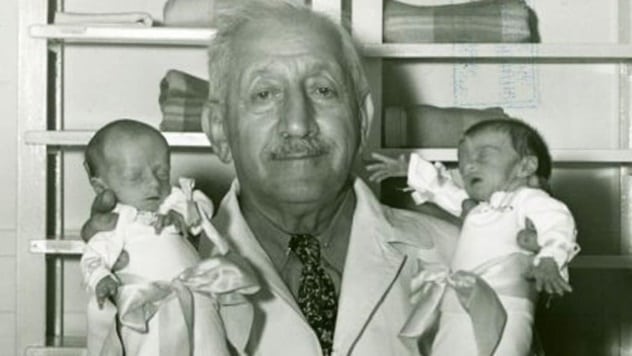 Weird Stuff
Weird Stuff  Weird Stuff
Weird Stuff  Our World
Our World 10 Archaeological Discoveries of 2025 That Refined History
 Weird Stuff
Weird Stuff 10 Fascinating Facts You Might Not Know About Snow
 Miscellaneous
Miscellaneous Top 10 Things Crypto Was Supposed to Change & What Actually Did
 History
History 10 Huge Historical Events That Happened on Christmas Eve
 Music
Music 10 Surprising Origin Stories of Your Favorite Holiday Songs
 History
History 10 Less Than Jolly Events That Occurred on December 25
 Weird Stuff
Weird Stuff 10 Funny Ways That Researchers Overthink Christmas
 Politics
Politics 10 Political Scandals That Sent Crowds Into the Streets
 Weird Stuff
Weird Stuff Ten Bizarre Facts About The Doge Meme
 Weird Stuff
Weird Stuff 10 Weird Things People Used to Do at New Year’s
 Our World
Our World 10 Archaeological Discoveries of 2025 That Refined History
 Weird Stuff
Weird Stuff 10 Fascinating Facts You Might Not Know About Snow
Who's Behind Listverse?

Jamie Frater
Head Editor
Jamie founded Listverse due to an insatiable desire to share fascinating, obscure, and bizarre facts. He has been a guest speaker on numerous national radio and television stations and is a five time published author.
More About Us Miscellaneous
Miscellaneous Top 10 Things Crypto Was Supposed to Change & What Actually Did
 History
History 10 Huge Historical Events That Happened on Christmas Eve
 Music
Music 10 Surprising Origin Stories of Your Favorite Holiday Songs
 History
History 10 Less Than Jolly Events That Occurred on December 25
 Weird Stuff
Weird Stuff 10 Funny Ways That Researchers Overthink Christmas
 Politics
Politics 10 Political Scandals That Sent Crowds Into the Streets
 Weird Stuff
Weird Stuff Ten Bizarre Facts About The Doge Meme
10 Offensive Things That Once Passed For Entertainment
What’s fun for one person can be fundamentally appalling to another. In fact, history is full of leisure activities where the offended parties certainly have a point. Standards change, although the following pastimes might make you wonder if the past even had standards.
From slaughtering animals on a moving train to mocking an entire race in motion pictures, it’s amazing (and more than a bit alarming) what used to pass for entertainment. Highlights—or shall we say lowlights—include a sex-offending skunk, an amusement park mini-city that treated little people like zoo animals, and a chart-topping song extolling the virtues of roofies.
10 Poor Tours: An International Slum-sation

Following the Industrial Revolution, late 19th-century London was among the Western world’s most economically imbalanced cities. In the twilight of the Victorian Era, East London in particular was impoverished and overflowing with working-class natives as well as Irish, Eastern European, and Jewish immigrants.
Across town, fabulously wealthy residents were just a carriage ride away, and they were intrigued by newspaper items describing the desperate state of the slums. And while some were motivated by religious or altruistic reasons, most were mere oglers and cheap thrill-seekers. Many even took voyeuristic vacations, donning disguises and spending a few nights among the poor in squalid tenements.
And then, slumming went international. In 1884, a headline in The New York Times proclaimed: “A Fashionable London Mania Reaches New-York. Slumming Parties to be the Rage This Winter.” For decades to come, well-to-do white New Yorkers spent their ample leisure time touring Harlem, Chinatown, the Lower East Side, and other downtrodden neighborhoods.[1]
In fact, the practice has endured to this day. Now known by such terms as “poorism” and “poverty porn,” touring impoverished areas has become a cottage industry around the world. Debates continue as to whether these constitute well-intending educational experiences or shameful schadenfreude.
9 The Original Drive-By Shooting

In the aftermath of the Civil War, the United States refocused on westward expansion. And to expand west unimpeded, something needed to be done about the Native Americans. One of the strategies involved destroying what, for many Native American tribes, was an irreplaceable lifeblood: the bison.
In short order, the millions of bison roaming the Great Plains were reduced to near-extinction. Not coincidentally, bison pelts had come into fashion, and by the 1880s, over 5,000 hunters were involved in the wholesale slaughter of whole herds. The picture above easily says 1,000 words about the tragedy that transpired.
But perhaps the most sickening part of the already carnivalesque carnage was when railroads started advertising hunting by rail,[2] which is a nice way of saying “blowing out bison brains from a moving train.” The ads flooded newspapers back east, and in no time, any “adventurous” gentlemen with a few bucks and a rifle could kill a beautiful beast just for fun—strewing the landscape with rotting, unutilized carcasses whose lives weren’t even worth slowing down for.
The spectacle was particularly macabre in instances where a herd would cross rail tracks. Slowing or stopping the train offered nearly point-blank, fish-in-a-barrel shootings that eliminated any already precarious semblance of sport.
8 Insult To Injury: Wild West Shows

History is typically written by those in power, and to the victors go the spoils. The turn-of-the-20th-century American spectacles of traveling Wild West Shows were among the most perverse examples of both. After driving an entire race of people into desperation and destitution, enterprising entertainers such as the celebrated “Buffalo Bill” Cody made them relive their humiliation in fictionalized accounts of white valor and Native American barbarism.[3]
By the 1880s, the Wild West had been tamed. Native Americans were herded onto desolate reservations whose landscapes looked nothing like their established homes, meaning their ways of life, and ability to support themselves, had been decimated.
Among the few job prospects was playing themselves—or, rather, whitewashed versions of themselves—in traveling shows romanticizing the closing American frontier. Not surprisingly, indigenous peoples were portrayed as unprovoked murderers and thieves and conquered by blameless white heroes in front of packed houses. To an entertained public, the performances, which ran well into the early 1900s, solidified notions of “Indians” as subhuman savages whose fate was fully deserved.
Sadly, many prominent Native Americans were lured into participating, usually as the only means to escape abject poverty. Cody featured Sitting Bull in his show in 1885, and for a competing show, the legendary Geronimo was advertised as “The Worst Indian That Ever Lived”—a typically sensationalist sentiment. He appeared in Cody’s show, as well.
7 The Little Things That Thrill

Along with Steeplechase and Luna Park, Dreamland was among the original three amusement parks that cemented the carnival legacy of New York City’s Coney Island. And though it only operated from 1904 to 1911, Dreamland established itself among the most ambitious entertainment-driven projects ever, well, dreamed up.
Illuminated by an otherworldly one million light bulbs, Dreamland’s imaginative attractions included a gondola ride through a recreated Venice, a train journey through the Swiss Alps, complete with gusts of frosty air, and a twice-daily six-story tenement building fire fought by scores of actors.
But one spectacle stooped really low: Lilliputia, a pint-sized European village where some 300 little people lived full-time.[4] Also known as the now-offensive “Midget City,” the tiny town was lined with half-size houses stocked with small-scale furniture and even had stables with miniature horses.
Collected from fairs and carnival sideshows across the country, its inhabitants performed in circuses, plays, and even operas for visitors. And since Coney Island is a beach destination, Lilliputia also had a stretch of sand frequented by small sunbathers and decked out with the littlest of lifeguard chairs.
Suffice to say, treating little people like a zoo exhibit would create more than a small stir today.
6 A Star Is Born: Preemie Voyeurism

Dreamland was so odd that it merits twin billing on this list. A short stroll from Lilliputia brought visitors to an attraction even stranger—and whose stars were even smaller. A special-admission sideshow featured premature babies being kept alive by a brand new invention: incubators.[5]
The dazzling devices were the brainchild of Dr. Martin Couney, who, upon developing the lifesaving contraption, realized that the clinical operating costs were impossibly prohibitive. Charging goo-goo gaga-ing gawkers an extra 25 cents (about $7 in today’s money) helped fund the facility.
Like its residents, the incubator installation was ahead of its time: When the exhibit opened in 1903, premature babies were considered genetically inferior and, from a medical standpoint, lost causes doomed to die. Couney’s invention disproved this assumption, showing that, with proper care, babies born early could indeed develop into healthy children.
Although the spectacle was shunned by the medical community, Couney’s clinic luckily did not burn to the ground in 1911 with the rest of Dreamland. Instead, it remained open until 1943—and revolutionized pediatric science in the process. In hindsight, it’s one offensive idea worth defending.
5 The Amazing (And Disgusting) Pervasiveness Of Blackface Performances

Given the United States’ troubling racial legacy, the advent of blackface minstrelsy—comedic performances of “blackness” by whites in exaggerated costumes and makeup—is unremarkable. What is surprising is how widespread, enduring, and popular it was as a form of entertainment.
The first minstrel shows date to 1830s New York City, featuring white performers sporting tattered clothing and faces blackened with shoe polish. The actors characterized blacks as lazy, ignorant, sexually promiscuous thieves. Among the most popular recurring characters was Jim Crow, a term now best known for the repressive anti-black laws passed throughout the post-Civil War Southern US.
Something this offensive couldn’t possibly go ultra-mainstream . . . right?
Wrong. Blackface endured through the 19th century and, in the early 20th, made the leap to the big screen.[6] Movies with abhorrent titles like Wooing and Wedding of a Coon and the feminist gem Coon Town Suffragettes were produced, and toxic characters with names like Stepin Fetchit and Sleep ‘n Eat concocted, well into the first half of the 1900s.
Blackface was so mainstream that a lengthy list of Hollywood stars appeared in films either as blackface characters or with them. These include Bing Crosby, Milton Berle, Fred Astaire, Shirley Temple, Judy Garland, and future US president Ronald Reagan.
4 Will Foxtrot For Food: The Great Depression’s Dancing Destitute

Beginning in the mid-1920s as fun-filled endurance competitions, dance marathons were last-couple-standing contests in which the duo who could Charleston, Jitterbug, and Lindy Hop the longest won prizes.
But when the New York stock market crashed in late 1929, ushering in the Great Depression, dance-a-thons took a darker, more desperate turn on the dance floor. Suddenly, those prizes were the only income many dancers had a chance to earn, transforming a lighthearted competition into something more resembling The Hunger Games.
With US unemployment exceeding 25 percent, destitute dancers weren’t difficult to find. Well-to-do patrons paid for the privilege to cackle as demeaned duos did everything in their power to outlast their fellow impoverished competitors. Many took turns napping in their partners’ arms during events that would stretch on for days or even weeks.
As added incentive in a nation ravaged by hunger, the dancers were typically fed so long as they kept dancing.[7]
All the while, onlookers watched and waited for dancers to quit, collapse, or have sleep-deprived nervous breakdowns. The schadenfreude-driven spectacles became so morbid that many states eventually banned them.
3 #MePew: The Sex Offender Skunk
Plenty of cartoons have featured questionable behavior at best: Elmer Fudd trying to murder an anthropomorphized bunny. Homer Simpson choking his son, Bart. Pretty much everything on South Park.
But the all-time award for “Worst Behavior in an Animated Program” undoubtedly goes to everyone’s favorite forced fornicator: Pepe Le Pew.
Granted, Fudd deserves an honorable mention for his armed pursuit of Bugs Bunny. But at least hunting wabbits is legal. Ol’ Pepe is consumed by the compulsion to commit interspecies rape.
His perpetual would-be victim is Penelope the Pussycat.[8] And ever since Pepe laid his skunk eyes on her, she’s been fleeing her odiferous, amorous assailant. Since Pepe’s debut in 1945, children have witnessed the attempted sexual subjugation of a female feline . . . and apparently found it amusing enough to make Pepe a Merrie Melodies regular.
It’s unfair to judge cartoonists in the first half of the 20th century by 2018 standards, but was attempted rape acceptable enough in the postwar West that it was fodder for children’s entertainment? New episodes were made until 1962 and reran for decades afterward. Sacrebleu!
2 Flipper: Not Really Smiling
Long before the controversial orca show in Sea World, there was America’s favorite dolphin, right in everyone’s living rooms.
Purportedly faster than lightning and smarter than his fellow seafarers, Flipper was a hit TV show from 1964 to 1967. The marine mammal saved would-be drowning victims, caught criminals, and even (for some reason) once flew in a helicopter before diving down into the ocean depths to save the day.
Only in reality, that wasn’t Flipper. A dead, frozen dolphin was tossed from the helicopter. Granted, entertainment was tricky in the days before CGI allowed filmmakers to create pretty much any visual they wanted. But the show has an even darker story.
Flipper was portrayed by a handful of dolphins. A few years after the show’s cancellation, one of them committed suicide.[9] Yes, apparently dolphins can do that.
One day in 1970, after years in captivity, Kathy the dolphin swam into the arms of her longtime trainer, Ric O’Barry. She then ceased breathing, sinking to the bottom of her tank. Unlike humans, dolphins can choose to stop breathing (we can’t—try it). O’Barry, who soon after described Kathy as “really depressed,” went on to be a marine mammal rights activist, even authoring a 1988 memoir called Behind the Dolphin Smile.
Programs and films with animal stars are often met with questions about their humane treatment. In Flipper ’s case, those worries were warranted.
1 Funky Cold Rohypnol
Examples abound of songs that, either by being dated or just plain degrading, disrespect women. From the old-fashioned, no-means-no-noncompliant holiday classic “Baby, It’s Cold Outside”[10] to rappers perched on giant female posteriors, the music industry has had the objectification of women down to a science for generations.
Few songs, however, are disturbing on the level of 1989’s “Funky Cold Medina.” It’s basically a song about roofie-ing women.
The story unfolds as follows: Like any red-blooded gent, Tone Loc—the same artist who brought us the similarly racy (but refreshingly rape-free) “Wild Thing”—was out on the town, an eligible bachelor in the market to meet some bachelorettes. Upon entering a local watering hole, however, our hero is puzzled by the number of attractive, seemingly amorous young ladies keeping the company of a less conventionally appealing chap.
Naturally, Tone couldn’t help but query the pub’s most popular bloke as to his secret. Per the lyrics:
This brother told me a secret on how to get more chicks,
Put a little Medina in your glass, and the girls will come real quick.
It’s better than any alcohol or aphrodisiac,
A couple of sips of this love potion, and she’ll be on your lap.
Undeterred by the prospect of committing felony sexual assault, Mr. Loc decided to employ the somehow novel strategy of spiking someone’s drink to get them in the bedroom. Unluckily for him, it backfired. Per the lyrics:
I took her to my crib, and everything went well as planned,
But when she got undressed, it was a big old mess, Sheena was a man!
Now that’s cold.
Christopher Dale frequently writes on society, politics, and sobriety-based issues. He’s been published in Salon, The Daily Beast, NY Daily News, and Parents.com, among other outlets. Follow him on Twitter at @ChrisDaleWriter.
Read about more examples of offensive entertainment on 10 Of The Most Offensive Superheroes In The History Of Comics and The 10 Most Offensive Board Games Ever Published.








